Edit:
I made following changes and got an accuracy of about 80%.
- Changed epochs to 2300
- changed learning rate to 0.000006
- changed np.random.rand to np.random.randn
epochs and learning rate i can understand, but i have no idea whats up with rand and randn.
I am attempting digit classification of mnist database with a neural network of this structure
first layer => 784 neurons. Inputs not normalized.
hidden layer 1 => 30 neurons => activation function tanh
hidden layer 2 => 30 neurons => activation function tanh
output layer => 10 neurons => activation function softmax
cost function => cross entropy
learning rate is 0.000001, epochs are 30, batch size = 1
But the accuracy its attaining is just 11% and error is halting to a constant value (138328)( which is definitely bad ) after 20-25 epochs epochs
I have'nt put comments in the code, so if you find difficult in reading the code, just put in comments, i'll put comments in the code
NeuralNetwork class is
import numpy as np
import sys
import time
class NueralNetwork():
def __init__(self, input_size, hidden1_size, hidden2_size, output_size):
self.input_layer_size = input_size
self.hidden_layer1_size = hidden1_size
self.hidden_layer2_size = hidden2_size
self.output_layer_size = output_size
np.random.seed(1)
self.W1 = np.random.rand(self.input_layer_size, self.hidden_layer1_size)
self.W2 = np.random.rand(self.hidden_layer1_size, self.hidden_layer2_size)
self.W3 = np.random.rand(self.hidden_layer2_size, self.output_layer_size)
self.b1 = np.zeros((1, self.hidden_layer1_size))
self.b2 = np.zeros((1, self.hidden_layer2_size))
self.b3 = np.zeros((1, self.output_layer_size))
def train(self, input_values, label, batch_size, epochs, learning_rate, error=False):
self.batch_size = batch_size
self.learning_rate = learning_rate
print("training...")
starting_time = time.time()
N = len(input_values)
for j in range(epochs):
# "j" is the epoch number
i = 0
print("## Epoch: ", j+1, " ##")
print("Time Lapsed: ", time.time() - starting_time)
self.error(input_values, label)
while i+batch_size < N:
sys.stdout.write("\rCompleted " + str((100*i/N)) + " in epoch " + str(j+1))
sys.stdout.flush()
X = input_values[i:i+batch_size]
y = label[i:i+batch_size]
i = i+batch_size
z1 = X @ self.W1 + self.b1
a1 = np.tanh(z1)
z2 = a1 @ self.W2 + self.b2
a2 = np.tanh(z2)
z3 = a2 @ self.W3 + self.b3
a3_temp = np.exp(z3)
a3 = a3_temp / np.sum(a3_temp, keepdims=True, axis=1)
delta4 = a3
delta4[range(len(y)), y] -= 1
# print(delta3)
# print(delta3.shape)
dw3 = a2.T @ delta4
db3 = np.sum(delta4, axis=0, keepdims=True)
# print(delta4.shape, " d4")
# print(db3.shape, " db3")
delta3 = (delta4 @ self.W3.T) * (1 - np.power(a2, 2))
dw2 = np.dot(a1.T, delta3)
db2 = np.sum(delta3, axis=0)
delta2 = (delta3 @ self.W2.T) * (1 - np.power(a1, 2))
dw1 = np.dot(X.T, delta2)
db1 = np.sum(delta2, axis=0)
self.W1 += -learning_rate * dw1
self.b1 += -learning_rate * db1
self.W2 += -learning_rate * dw2
self.b2 += -learning_rate * db2
self.W3 += -learning_rate * dw3
self.b3 += -learning_rate * db3
if error:
self.error(input_values, label)
print("")
def error(self, X, y):
z1 = X @ self.W1 + self.b1
a1 = np.tanh(z1)
z2 = a1 @ self.W2 + self.b2
a2 = np.tanh(z2)
z3 = a2 @ self.W3 + self.b3
a3_temp = np.exp(z3)
a3 = a3_temp / np.sum(a3_temp, keepdims=True, axis=1)
correct_loss = -np.log(a3[range(len(y)), y])
data_loss = np.sum(correct_loss)
print(data_loss)
def show_performance(self, X, y):
print("Error is: ", end="")
z1 = X @ self.W1 + self.b1
a1 = np.tanh(z1)
z2 = a1 @ self.W2 + self.b2
a2 = np.tanh(z2)
z3 = a2 @ self.W3 + self.b3
a3_temp = np.exp(z3)
a3 = a3_temp / np.sum(a3_temp, keepdims=True, axis=1)
y_p = np.argmax(a3, axis=1)
self.error(X, y)
score = 0
for i in range(len(y)):
if y_p[i] == y[i]:
score += 1
print("Score is ", score/len(y))
train_images, train_label, test_images, test_label = initial.load_data_mnist()
nn = NueralNetwork(784, 30, 30, 10)
nn.train(train_images, train_label, 1, 20, 0.000001)
nn.show_performance(test_images, test_label)
data is coming from here. 'data' directory has the mnist database files
from mnist import MNIST
import numpy as np
def load_data_mnist():
mdata = MNIST('data')
train_images, train_labels = mdata.load_training()
test_images, test_labels = mdata.load_testing()
return np.array(train_images), np.array(train_labels), np.array(test_images), np.array(test_labels)

